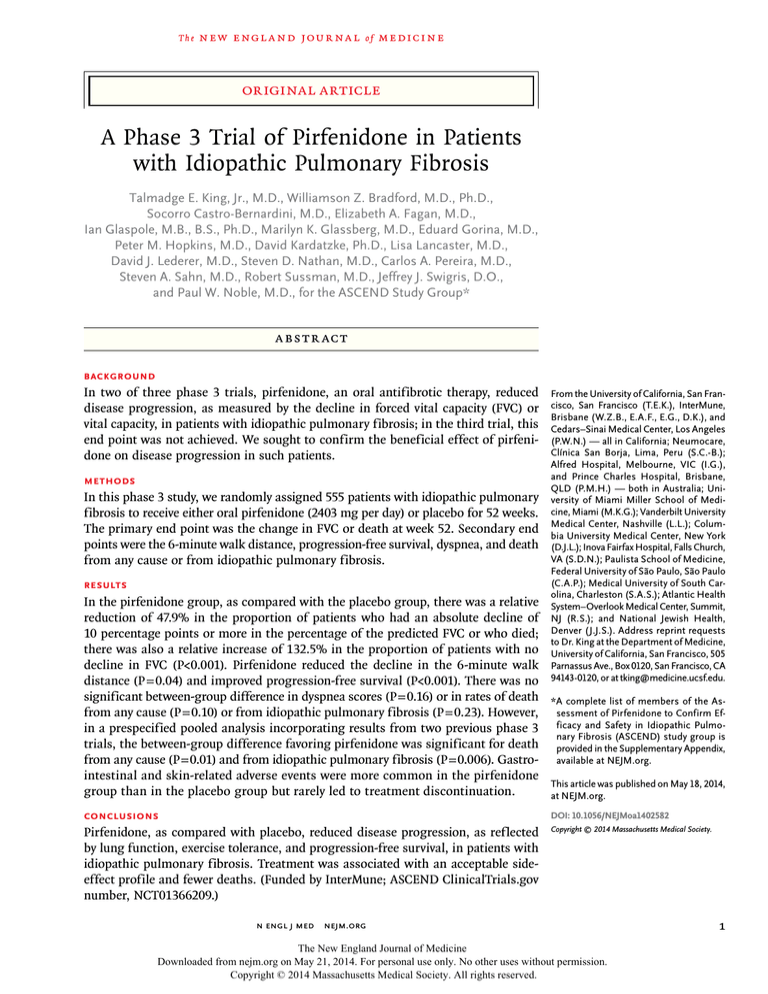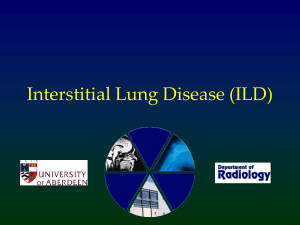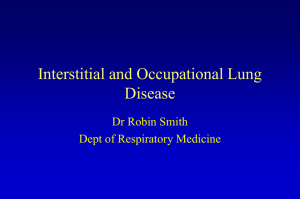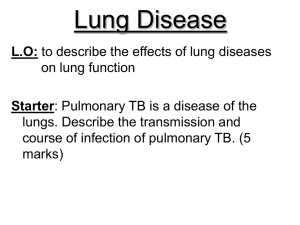
The
n e w e ng l a n d j o u r na l
of
m e dic i n e
original article
A Phase 3 Trial of Pirfenidone in Patients
with Idiopathic Pulmonary Fibrosis
Talmadge E. King, Jr., M.D., Williamson Z. Bradford, M.D., Ph.D.,
Socorro Castro-Bernardini, M.D., Elizabeth A. Fagan, M.D.,
Ian Glaspole, M.B., B.S., Ph.D., Marilyn K. Glassberg, M.D., Eduard Gorina, M.D.,
Peter M. Hopkins, M.D., David Kardatzke, Ph.D., Lisa Lancaster, M.D.,
David J. Lederer, M.D., Steven D. Nathan, M.D., Carlos A. Pereira, M.D.,
Steven A. Sahn, M.D., Robert Sussman, M.D., Jeffrey J. Swigris, D.O.,
and Paul W. Noble, M.D., for the ASCEND Study Group*
A bs t r ac t
Background
In two of three phase 3 trials, pirfenidone, an oral antifibrotic therapy, reduced
disease progression, as measured by the decline in forced vital capacity (FVC) or
vital capacity, in patients with idiopathic pulmonary fibrosis; in the third trial, this
end point was not achieved. We sought to confirm the beneficial effect of pirfenidone on disease progression in such patients.
Methods
In this phase 3 study, we randomly assigned 555 patients with idiopathic pulmonary
fibrosis to receive either oral pirfenidone (2403 mg per day) or placebo for 52 weeks.
The primary end point was the change in FVC or death at week 52. Secondary end
points were the 6-minute walk distance, progression-free survival, dyspnea, and death
from any cause or from idiopathic pulmonary fibrosis.
Results
In the pirfenidone group, as compared with the placebo group, there was a relative
reduction of 47.9% in the proportion of patients who had an absolute decline of
10 percentage points or more in the percentage of the predicted FVC or who died;
there was also a relative increase of 132.5% in the proportion of patients with no
decline in FVC (P<0.001). Pirfenidone reduced the decline in the 6-minute walk
distance (P = 0.04) and improved progression-free survival (P<0.001). There was no
significant between-group difference in dyspnea scores (P = 0.16) or in rates of death
from any cause (P = 0.10) or from idiopathic pulmonary fibrosis (P = 0.23). However,
in a prespecified pooled analysis incorporating results from two previous phase 3
trials, the between-group difference favoring pirfenidone was significant for death
from any cause (P = 0.01) and from idiopathic pulmonary fibrosis (P = 0.006). Gastrointestinal and skin-related adverse events were more common in the pirfenidone
group than in the placebo group but rarely led to treatment discontinuation.
From the University of California, San Francisco, San Francisco (T.E.K.), InterMune,
Brisbane (W.Z.B., E.A.F., E.G., D.K.), and
Cedars–Sinai Medical Center, Los Angeles
(P.W.N.) — all in California; Neumocare,
Clínica San Borja, Lima, Peru (S.C.-B.);
Alfred Hospital, Melbourne, VIC (I.G.),
and Prince Charles Hospital, Brisbane,
QLD (P.M.H.) — both in Australia; University of Miami Miller School of Medicine, Miami (M.K.G.); Vanderbilt University
Medical Center, Nashville (L.L.); Columbia University Medical Center, New York
(D.J.L.); Inova Fairfax Hospital, Falls Church,
VA (S.D.N.); Paulista School of Medicine,
Federal University of São Paulo, São Paulo
(C.A.P.); Medical University of South Carolina, Charleston (S.A.S.); Atlantic Health
System–Overlook Medical Center, Summit,
NJ (R.S.); and National Jewish Health,
Denver (J.J.S.). Address reprint requests
to Dr. King at the Department of Medicine,
University of California, San Francisco, 505
Parnassus Ave., Box 0120, San Francisco, CA
94143-0120, or at tking@medicine.ucsf.edu.
*A complete list of members of the Assessment of Pirfenidone to Confirm Efficacy and Safety in Idiopathic Pulmonary Fibrosis (ASCEND) study group is
provided in the Supplementary Appendix,
available at NEJM.org.
This article was published on May 18, 2014,
at NEJM.org.
Conclusions
DOI: 10.1056/NEJMoa1402582
Pirfenidone, as compared with placebo, reduced disease progression, as reflected
by lung function, exercise tolerance, and progression-free survival, in patients with
idiopathic pulmonary fibrosis. Treatment was associated with an acceptable sideeffect profile and fewer deaths. (Funded by InterMune; ASCEND ClinicalTrials.gov
number, NCT01366209.)
Copyright © 2014 Massachusetts Medical Society.
n engl j med nejm.org
The New England Journal of Medicine
Downloaded from nejm.org on May 21, 2014. For personal use only. No other uses without permission.
Copyright © 2014 Massachusetts Medical Society. All rights reserved.
1
The
n e w e ng l a n d j o u r na l
I
diopathic pulmonary fibrosis is a
chronic, progressive, and fatal lung disease
that is characterized by irreversible loss of
lung function.1 Although periods of transient
clinical stability may be observed, continued progression of the disease is inevitable.2 The prognosis is poor, with a 5-year survival rate that is
similar to the rates for several cancers.3-6
Pirfenidone is an oral antifibrotic therapy
that has been evaluated for the treatment of idiopathic pulmonary fibrosis in three phase 3, randomized, controlled trials. One of these trials was
conducted in Japan and involved 275 patients. It
was followed by two multinational studies, Clinical Studies Assessing Pirfenidone in Idiopathic
Pulmonary Fibrosis: Research of Efficacy and
Safety Outcomes (CAPACITY studies 004 and 006),
that were conducted in the United States, Europe, and Australia and involved 779 patients.7,8
In the Japanese trial, pirfenidone reduced the
decline in vital capacity at week 52 and improved progression-free survival. In the multinational trials, the primary end point of change
from baseline to week 72 in the percentage of
the predicted forced vital capacity (FVC) was met
in study 004 but not in study 006, prompting U.S.
regulatory authorities to request an additional
trial to support the approval of pirfenidone.
In the Assessment of Pirfenidone to Confirm
Efficacy and Safety in Idiopathic Pulmonary Fibrosis (ASCEND) study, a randomized, double-blind,
placebo-controlled trial, we aimed to confirm the
effect of pirfenidone on disease progression in patients with idiopathic pulmonary fibrosis. Our design modifications with respect to the CAPACITY
trial included the implementation of centralized
procedures for diagnosis, spirometry, and adjudication of deaths; a minor modification of eligibility criteria to allow enrollment of patients
with an increased risk of disease progression;
and a standard 1-year study period.
Me thods
Study Sites and Patients
of
m e dic i n e
sus guidelines, were findings on high-resolution
computed tomography (HRCT) that indicated either definite or possible usual interstitial pneumonia; the latter was confirmed on surgical lung
biopsy.1 Other criteria for enrollment included a
range of 50 to 90% of the predicted FVC, a range
of 30 to 90% of the predicted carbon monoxide
diffusing capacity, a ratio of the forced expiratory
volume in 1 second (FEV1) to the FVC of 0.80 or
more, and a 6-minute walk distance of 150 m or
more. (A comprehensive list of inclusion and exclusion criteria is provided in the Supplementary
Appendix, available with the full text of this article at NEJM.org.) All patients provided written
informed consent.
Study Design and Assessments
Eligible patients were randomly assigned to receive oral pirfenidone (at a dose of 2403 mg per
day) or placebo for 52 weeks. The study drug was
administered with food in three equally divided
doses, and the dose was gradually increased to
the full dose over a 2-week period. Randomization codes were generated by computer with the
use of a permuted-block design, and the study
drug was assigned by means of an interactive
voice-response system. Concomitant treatment
with any investigational therapy was prohibited.
Selected concomitant medications that are used
for the treatment of idiopathic pulmonary fibrosis were permitted if they were used for another
indication, provided that there was no clinically
acceptable alternative.
Physical examination and clinical laboratory
assessments were performed at baseline and at
weeks 2, 4, 8, 13, 26, 39, and 52. Pulmonary function, exercise tolerance, and dyspnea were assessed at baseline and at weeks 13, 26, 39, and 52.
Central reviewers at Biomedical Systems, who
were unaware of study-group assignments, evaluated all FVC results for adequacy and repeatability, according to the criteria of the American
Thoracic Society.9 A data and safety monitoring
committee reviewed safety and efficacy data
throughout the trial.
The study protocol was approved by the institutional review board or ethics committee at
each participating center. The protocol and statistical analysis plan are available at NEJM.org.
The study was conducted at 127 sites in 9 countries (11 sites in Australia, 6 in Brazil, 2 in Croatia,
5 in Israel, 5 in Mexico, 2 in New Zealand, 8 in
Peru, 1 in Singapore, and 87 in the United States).
Eligible patients were between the ages of 40 and
80 years and had received a centrally confirmed Study Oversight
diagnosis of idiopathic pulmonary fibrosis. The The study sponsor (InterMune) and the steering
diagnostic criteria, based on published consen- committee cochairs were primarily responsible
2
n engl j med nejm.org
The New England Journal of Medicine
Downloaded from nejm.org on May 21, 2014. For personal use only. No other uses without permission.
Copyright © 2014 Massachusetts Medical Society. All rights reserved.
Pirfenidone for Idiopathic Pulmonary Fibrosis
for the design of the study. All authors participated in the conduct of the study, analysis of data,
and reporting of the results. A writing committee
comprising the first and last authors, the study
medical monitor, and a medical writer (who was
paid by the study sponsor) prepared the first
draft of the manuscript. All authors vouch for the
accuracy and completeness of the report and for
the fidelity of the report to the protocol; all the
authors critically reviewed the manuscript and
approved the final draft. All the authors had full
access to data, and no limits were placed on the
content of the report.
Statistical Analysis
The primary efficacy end point was the change
from baseline to week 52 in the percentage of the
predicted FVC in the intention-to-treat population. The test statistic for the primary efficacy
analysis was a ranked analysis of covariance
(ANCOVA), with the average standardized rank
change in the percentage of the predicted FVC as
the outcome variable and the standardized rank
baseline value as a covariate. The primary efficacy analysis was tested with the use of a final
two-tailed P value of 0.0498, which was adjusted
for two planned interim analyses. The magnitude of the treatment effect was estimated by
comparing the distribution of patients in the pirfenidone group with those in the placebo group
across two thresholds of change at week 52: an
absolute decline of 10 percentage points in the
percentage of the predicted FVC or death, or no
decline in the percentage of the predicted FVC.
Supportive analyses to assess the robustness of
the effect on FVC were also conducted.
Two key secondary end points and three additional secondary end points were prespecified.
The key secondary end points, which were analyzed with the use of the Hochberg procedure for
multiple comparisons,10 were the change from
baseline to week 52 in the 6-minute walk distance
and progression-free survival. Progression-free
survival was defined as the time to the first
occurrence of any one of the following: a confirmed decrease of 10 percentage points or
more in the percentage of the predicted FVC, a
confirmed decrease of 50 m or more in the
6-minute walk distance, or death. Additional
secondary end points included change in dyspnea, which was measured with the use of the
University of California San Diego Shortness of
Breath Questionnaire (UCSD SOBQ), with scores
ranging from 0 to 120 and higher scores indi­
cating worse dyspnea (minimally important difference, 5 to 11 points) (Fig. S4 in the Supplementary
Appendix); the rate of death from any cause; and
the rate of death from idiopathic pulmonary fibrosis during the period from baseline to 28 days after
the last dose of the study drug.
In accordance with the prespecified statistical analysis plan, rates of death from any cause
and death from idiopathic pulmonary fibrosis
were analyzed in the ASCEND study population
and in the pooled population from the ASCEND
trial and the two CAPACITY trials; the latter analysis was performed for the purpose of increasing
the statistical power and deriving a more stable
estimate of the treatment effect. For the pooled
analysis, CAPACITY results were censored at
day 365 so that the follow-up time would be the
same for all three studies. The primary cause of
death and its relation to idiopathic pulmonary
fibrosis were assessed in a blinded fashion by
an independent mortality assessment committee in the ASCEND trial and by the site investigators in the CAPACITY trials (Tables S1 and S2
in the Supplementary Appendix).
All efficacy analyses were conducted in the
intention-to-treat population with the use of SAS
software, version 9.2 (SAS Institute). For the ranked
ANCOVA analyses, missing values owing to death
were assigned the worst ranks, with early deaths
ranked worse than later deaths. In analyses of
mean change, missing values owing to death
were assigned the worst possible outcome (e.g.,
FVC = 0). Missing values for reasons other than
death were imputed as the average value for the
three patients with the smallest sum of squared
differences at each visit. For time-to-event analyses, pirfenidone was compared with placebo with
the use of a log-rank test; hazard ratios were
based on the Cox proportional-hazards model.
Adverse events were coded according to preferred terms in the Medical Dictionary for Regulatory
Activities, version 11.0. Safety outcomes are reported as events that occurred in the period
from baseline to 28 days after the last dose of
the study drug.
R e sult s
Study Patients
From July 2011 through January 2013, a total of
555 patients were enrolled; 278 were assigned to
receive pirfenidone, and 277 were assigned to re-
n engl j med nejm.org
The New England Journal of Medicine
Downloaded from nejm.org on May 21, 2014. For personal use only. No other uses without permission.
Copyright © 2014 Massachusetts Medical Society. All rights reserved.
3
The
n e w e ng l a n d j o u r na l
ceive placebo. Demographic and baseline characteristics are summarized in Table 1. There were no
significant imbalances in clinically relevant baseline characteristics between the two study groups.
The majority of patients were male (79.9% and
76.9% in the pirfenidone and placebo groups, respectively), white (91.7% and 90.6%, respectively),
and 65 years of age or older (73.7% and 68.2%,
respectively). The mean (±SD) baseline FVC was
67.8±11.2% of the predicted value in the pirfenidone group and 68.6±10.9% of the predicted value
in the placebo group.
A total of 522 patients (94.1%) completed the
study: 261 patients (93.9%) in the pirfenidone
group and 261 patients (94.2%) in the placebo
group (Fig. 1). Study treatment was discontinued
prematurely in 55 patients (19.8%) in the pirfenidone group and in 39 patients (14.1%) in the
Table 1. Characteristics of the Patients at Baseline.*
Pirfenidone
(N = 278)
Characteristic
Age — yr
Placebo
(N = 277)
68.4±6.7
67.8±7.3
Male sex — no. (%)
222 (79.9)
213 (76.9)
U.S. enrollment — no. (%)
187 (67.3)
184 (66.4)
Former smoker — no. (%)
184 (66.2)
169 (61.0)
FVC — % of predicted value
67.8±11.2
68.6±10.9
FEV1:FVC
0.84±0.03
0.84±0.04
Carbon monoxide diffusing capacity —
% of predicted value
43.7±10.5
44.2±12.5
Lung physiological features
Dyspnea score†
34.0±21.9
36.6±21.7
Distance on 6-min walk test — m
415.0±98.5
420.7±98.1
Use of supplemental oxygen — no. (%)
78 (28.1)
76 (27.4)
1.7±1.1
1.7±1.1
Time since diagnosis — yr
Diagnostic finding on high-resolution
computed tomography — no. (%)
Definite pattern of usual interstitial
pneumonia
266 (95.7)
262 (94.6)
Possible pattern of usual interstitial
pneumonia‡
12 (4.3)
15 (5.4)
86 (30.9)
79 (28.5)
Surgical lung biopsy — no. (%)
*Plus–minus values are means ±SD. There were no significant differences between the two groups in any of the baseline characteristics shown. FEV1 denotes forced expiratory volume in one second, and FVC forced vital capacity.
†Dyspnea was evaluated with the use of the University of California, San Diego,
Shortness of Breath Questionnaire, scores on which range from 0 to 120, with
higher scores indicating worse dyspnea; the minimally important difference is
5 to 11 points.
‡The diagnosis was subsequently confirmed on surgical lung biopsy indicating
a histologic pattern of usual interstitial pneumonia. 4
of
m e dic i n e
placebo group. Adherence to the study treatment
was high; 237 patients (85.3%) and 256 (92.4%)
patients in the pirfenidone and placebo groups,
respectively, received at least 80% of the prescribed doses of the assigned study drug.
Primary Efficacy Analysis
In the ranked ANCOVA analysis, treatment with
pirfenidone resulted in a significant betweengroup difference in the primary end point, the
change from baseline to week 52 in the percentage
of the predicted FVC (P<0.001). At week 52, the proportion of patients who had a decline of 10 percentage points or more in the percentage of the predicted FVC or who had died was reduced by 47.9%
in the pirfenidone group as compared with the
placebo group (46 patients [16.5%] vs. 88 patients
[31.8%]) (Fig. 2A), and the proportion of patients
with no decline in the percentage of the predicted
FVC was increased by 132.5% in the pirfenidone
group (63 patients [22.7%] vs. 27 patients [9.7%])
(Fig. S1 in the Supplementary Appendix).
The treatment effect was evident by week 13
and increased throughout the duration of the
trial. Supportive analyses of the primary end
point yielded similar results. The mean decline
from baseline in FVC was 235 ml in the pirfenidone group and 428 ml in the placebo group
(absolute difference, 193 ml; relative difference,
45.1%; P<0.001) (Fig. 2B). The linear slope of decline in FVC at week 52 was −122 ml in the pirfenidone group and −262 ml in the placebo group
(absolute difference, 140 ml; relative difference,
53.5%; P<0.001) (Fig. S2 in the Supplementary
Appendix).
Prespecified Secondary Efficacy Analyses
Pirfenidone resulted in a significant betweengroup difference in the change from baseline to
week 52 in the 6-minute walk distance (P = 0.04).
At week 52, a decrease of 50 m or more in the
6-minute walk distance or death occurred in 72 patients (25.9%) in the pirfenidone group and in
99 patients (35.7%) in the placebo group, for a
relative reduction of 27.5% in the pirfenidone
group (Fig. 2C, and Fig. S3 in the Supplementary
Appendix).
Pirfenidone, as compared with placebo, reduced the relative risk of death or disease progression by 43% (hazard ratio in the pirfenidone
group, 0.57; 95% confidence interval [CI], 0.43
to 0.77; P<0.001) (Fig. 2D). For each component
n engl j med nejm.org
The New England Journal of Medicine
Downloaded from nejm.org on May 21, 2014. For personal use only. No other uses without permission.
Copyright © 2014 Massachusetts Medical Society. All rights reserved.
Pirfenidone for Idiopathic Pulmonary Fibrosis
1562 Patients were assessed for eligibility
1007 Were excluded
445 Did not meet HRCT or lung-biopsy criteria
200 Had FVC <50% or >90%
171 Had DLCO <30% or >90%
152 Had FEV1:FVC ratio <0.80
130 Had greater extent of emphysema than
of fibrosis
555 Underwent randomization
278 Were assigned to receive pirfenidone
277 Were assigned to receive placebo
16 Discontinued study
7 Had adverse events
4 Withdrew
3 Withdrew consent
1 Was lost to follow-up
1 Was withdrawn by
sponsor
39 Discontinued treatment
24 Had adverse events
7 Withdrew
5 Died
1 Underwent lung transplantation
1 Was lost to follow-up
1 Had other reason
17 Discontinued study
6 Had adverse events
4 Withdrew
4 Withdrew consent
2 Were lost to follow-up
1 Was withdrawn by
physician
55 Discontinued treatment
35 Had adverse events
9 Withdrew
4 Died
6 Underwent lung transplantation
1 Had other reason
261 Completed study
223 Completed treatment
261 Completed study
238 Completed treatment
Figure 1. Enrollment and Outcomes.
The listed reasons for exclusion from the study were reported in at least 10% of the patients who underwent screening.
Patients could have more than one reason for exclusion. The numbers of patients who withdrew from the study do
not include patients who died or underwent lung transplantation. Patients who discontinued the study treatment
were included in the analysis of data for patients who completed the study. Dlco denotes carbon monoxide diffusing
capacity, FEV1 forced expiratory volume in one second, FVC forced vital capacity, and HRCT high-resolution computed tomography.
of the composite end point, fewer patients in the
pirfenidone group than in the placebo group
had a qualifying event, including death (3.6% vs.
5.1%), a confirmed absolute decrease of 10 percentage points or more in the percentage of the
predicted FVC (6.5% vs. 17.7%), and a confirmed
decrease of 50 m or more in the 6-minute walk
distance (16.5% vs. 19.5%).
Analysis of UCSD SOBQ scores showed no significant between-group difference in dyspnea at
week 52. The end point of an increase of 20 points
or more (indicating worsening) on the dyspnea
score or death occurred in 81 patients (29.1%) in
the pirfenidone group and in 100 patients (36.1%)
in the placebo group (absolute difference, 7.0 percentage points; relative reduction, 19.3%; P = 0.16)
(Fig. S4 in the Supplementary Appendix).
Mortality Outcomes
Analysis of all-cause mortality showed fewer
deaths in the pirfenidone group than in the placebo group, although the difference was not significant. Eleven patients (4.0%) in the pirfenidone group died during the study, as compared
n engl j med nejm.org
The New England Journal of Medicine
Downloaded from nejm.org on May 21, 2014. For personal use only. No other uses without permission.
Copyright © 2014 Massachusetts Medical Society. All rights reserved.
5
The
n e w e ng l a n d j o u r na l
A Decreased FVC or Death
30
Pirfenidone (N=278)
Placebo (N=277)
Patients (%)
Pirfenidone (N=278)
−100
P<0.001
20
P<0.001
15
10
0
0
P<0.001
25
5
m e dic i n e
B Change in FVC
Mean Change (ml)
35
of
−200
−300
−400
P<0.001
Placebo (N=277)
−500
13
26
39
0
52
13
Week
26
39
52
Week
C Decreased Walk Distance or Death
D Progression-free Survival
100
35
Pirfenidone (N=278)
Placebo (N=277)
30
P=0.12
P=0.04
80
25
20
15
P=0.40
70
60
Placebo (N=277)
50
40
Hazard ratio, 0.57 (95% CI, 0.43–0.77)
P<0.001
30
20
10
10
5
0
Pirfenidone (N=278)
90
P=0.04
Patients (%)
Patients (%)
40
0
13
26
39
Week
0
13
52
26
39
52
219
192
144
113
Week
No. at Risk
Pirfenidone
Placebo
276
273
269
262
243
225
Figure 2. Primary and Key Secondary Efficacy Outcomes during the 52-Week Study Period.
Panel A shows the proportion of patients who had a decreased percentage of the predicted FVC (defined as a decline of at least 10 percentage
points from baseline) or who died. Panel B shows the mean change from baseline in FVC. Panel C shows the proportion of patients who had a
decreased walk distance (defined as a decline of 50 m or more in the distance walked in 6 minutes) or who died. P values shown in Panels A,
B, and C were calculated with the use of ranked analysis of covariance. Panel D shows the Kaplan–Meier distribution for the probability
of progression-free survival. The P value was calculated with the use of the log-rank test.
with 20 patients (7.2%) in the placebo group
(hazard ratio, 0.55; 95% CI, 0.26 to 1.15; P = 0.10).
Deaths from idiopathic pulmonary fibrosis occurred in 3 patients (1.1%) and 7 patients (2.5%) in
the pirfenidone and placebo groups, respectively
(hazard ratio, 0.44; 95% CI, 0.11 to 1.72; P = 0.23).
In the prespecified analysis of all-cause mortality in the pooled population of 1247 patients
(555 from the ASCEND study and 692 from the
CAPACITY studies), pirfenidone reduced the risk
of death at 1 year by 48%, as compared with
placebo (hazard ratio, 0.52; 95% CI, 0.31 to 0.87;
P = 0.01) (Table 2). In addition, in the pooled population, the risk of death from idiopathic pulmo-
6
n engl j med
nary fibrosis at 1 year was reduced by 68% in the
pirfenidone group, as compared with the placebo
group (hazard ratio, 0.32; 95% CI, 0.14 to 0.76;
P = 0.006). (Additional mortality results are provided in Tables S3, S4, and S5 in the Supplementary Appendix.)
Adverse Events
Adverse events that occurred during the study period are summarized in Table 3. Gastrointestinal
and skin-related events were more common in
the pirfenidone group than in the placebo group;
these events were generally mild to moderate in
severity, reversible, and without clinically signifi-
nejm.org
The New England Journal of Medicine
Downloaded from nejm.org on May 21, 2014. For personal use only. No other uses without permission.
Copyright © 2014 Massachusetts Medical Society. All rights reserved.
Pirfenidone for Idiopathic Pulmonary Fibrosis
Table 2. Mortality in the ASCEND and CAPACITY Trials.*
Variable
Hazard Ratio
(95% CI)†
Pirfenidone
Placebo
P Value‡
278
277
11 (4.0)
20 (7.2)
0.55 (0.26–1.15)
0.10
3 (1.1)
7 (2.5)
0.44 (0.11–1.72)
0.23
623
624
22 (3.5)
42 (6.7)
0.52 (0.31–0.87)
0.01
7 (1.1)
22 (3.5)
0.32 (0.14–0.76)
0.006
ASCEND trial
No. of patients
Death — no. (%)
From any cause
Related to idiopathic pul­mo­nary fibrosis§
Pooled data from ASCEND and CAPACITY trials
No. of patients
Death — no. (%)
From any cause
Related to idiopathic pulmo­nary fibrosis§
*Data from the two CAPACITY studies8 were censored at 1 year to standardize the follow-up for the three studies.
†Hazard ratios are for the pirfenidone group, as compared with the placebo group, and were calculated with the use of
the Cox proportional-hazards model.
‡P values were calculated with the use of the log-rank test.
§Death related to idiopathic pulmonary fibrosis was defined as death that occurred during the period from randomization to 28 days after the last dose of the study drug. This category was evaluated in a blinded fashion by an independent mortality-assessment committee in the ASCEND trial and by clinical investigators in the CAPACITY trials.
cant sequelae. Grade 3 gastrointestinal adverse
events were reported in 15 patients (5.4%) in the
pirfenidone group and 4 patients (1.4%) in the
placebo group. Grade 3 skin-related adverse
events were reported in 5 patients (1.8%) in the
pirfenidone group and 1 patient (0.4%) in the
placebo group. No patients in either group had a
grade 4 gastrointestinal or skin-related event.
Cough, worsening of idiopathic pulmonary fibrosis, and dyspnea occurred more frequently in
the placebo group. There were fewer deaths in
the pirfenidone group than in the placebo group
(8 [2.9%] vs. 15 [5.4%] between baseline and 28
days after the last dose of a study drug).
The relative difference between treatment
groups in the overall incidence of serious adverse events is less clear. If worsening of idiopathic pulmonary fibrosis is counted as an adverse event (as specified in the protocol), there
were 55 patients (19.8%) in the pirfenidone
group and 69 patients (24.9%) in the placebo
group who had a serious adverse event. The most
common serious adverse event was worsening of
idiopathic pulmonary fibrosis, which was reported in 7 patients (2.5%) in the pirfenidone
group and in 27 patients (9.7%) in the placebo
group. However, since worsening of idiopathic
pulmonary fibrosis is a study outcome, it is rea-
sonable to exclude patients with worsening fibrosis in the analysis of serious adverse events.
With such patients excluded, serious adverse
events occurred in 52 patients (18.7%) in the
pirfenidone group and 56 patients (20.2%) in the
placebo group.
Elevations in the level of alanine or aspartate
aminotransferase (values that were three or
more times the upper limit of the normal range)
occurred in eight patients (2.9%) in the pirfenidone group and two patients (0.7%) in the placebo group, including one patient in the pirfenidone group who had a concurrent elevation in
the total bilirubin level that was more than two
times the upper limit of the normal range. All
aminotransferase elevations were reversible and
without clinically significant consequences.
Adverse events led to discontinuation of study
treatment in 40 patients (14.4%) in the pirfenidone group and 30 patients (10.8%) in the placebo group. The most common adverse event
resulting in treatment discontinuation was a
worsening of idiopathic pulmonary fibrosis in
3 patients (1.1%) in the pirfenidone group and
in 15 patients (5.4%) in the placebo group. The
only other adverse events leading to treatment
discontinuation in at least 1% of the patients in
the pirfenidone group were elevated hepatic en-
n engl j med nejm.org
The New England Journal of Medicine
Downloaded from nejm.org on May 21, 2014. For personal use only. No other uses without permission.
Copyright © 2014 Massachusetts Medical Society. All rights reserved.
7
The
n e w e ng l a n d j o u r na l
Table 3. Adverse Events.*
Pirfenidone
(N = 278)
Adverse Event
Placebo
(N = 277)
no. of patients (%)
Cough
70 (25.2)
82 (29.6)
Nausea
100 (36.0)
37 (13.4)
Headache
72 (25.9)
64 (23.1)
Diarrhea
62 (22.3)
60 (21.7)
Upper respiratory tract infection
61 (21.9)
56 (20.2)
Fatigue
58 (20.9)
48 (17.3)
Rash
78 (28.1)
24 (8.7)
Dyspnea
41 (14.7)
49 (17.7)
Dizziness
49 (17.6)
36 (13.0)
Idiopathic pulmonary fibrosis†
26 (9.4)
50 (18.1)
Bronchitis
39 (14.0)
36 (13.0)
Constipation
32 (11.5)
38 (13.7)
Back pain
30 (10.8)
37 (13.4)
Dyspepsia
49 (17.6)
17 (6.1)
Nasopharyngitis
33 (11.9)
30 (10.8)
Anorexia
44 (15.8)
18 (6.5)
Vomiting
36 (12.9)
24 (8.7)
Decrease in weight
35 (12.6)
22 (7.9)
Gastroesophageal reflux
33 (11.9)
18 (6.5)
Insomnia
31 (11.2)
18 (6.5)
*Listed are all adverse events that were reported in at least 10% of patients
in either study group. Preferred terms in the Medical Dictionary for Regulatory
Activities, version 11.0, were used for documentation of adverse events.
†Since idiopathic pulmonary fibrosis was a criterion for enrollment, this category of adverse events refers to worsening of disease.
zyme levels, pneumonia, rash, and decreased
weight in 3 patients (1.1%) each.
Discussion
In this phase 3 study comparing pirfenidone
with placebo in patients with idiopathic pulmonary fibrosis, treatment with pirfenidone for
52 weeks significantly reduced disease pro­
gression, as measured by changes in FVC, the
6-minute walk distance, and progression-free
survival. The treatment effect on FVC emerged
early and increased during the course of the
trial, resulting in an approximate halving in the
rate of decline at 1 year. The highly significant
finding with respect to the primary end point
was supported by the favorable effect on rates of
8
of
m e dic i n e
death from any cause and from idiopathic pulmonary fibrosis.
Treatment with pirfenidone was generally safe
and had an acceptable side-effect profile, findings
that are consistent with those in previous studies.7,8,11,12 Gastrointestinal and skin-related adverse events were more common in the pirfenidone group than in the placebo group; these
events were generally mild to moderate in severity
and led to treatment discontinuation in 2.2% and
2.9% of patients, respectively, in the pirfenidone
group and 1.1% and 0.4% of those, respectively,
in the placebo group. There were fewer serious
adverse events and deaths in the pirfenidone
group than in the placebo group. Clinically significant elevations in aminotransferase levels
occurred more frequently in the pirfenidone
group; however, these elevations occurred in
less than 3% of patients, were reversible, and
did not have clinically significant consequences.
The results of this study confirm and extend
the findings of the two CAPACITY trials (studies
004 and 006),8 each of which was smaller and of
longer duration than the ASCEND trial. An important observation in the CAPACITY 006 trial
was the attenuated rate of decline in FVC in the
placebo group, as compared with that in the
CAPACITY 004 study and another multinational
trial.13 In our study, we modified certain aspects
of the CAPACITY study design, including increasing the sample size and requiring central confirmation of the diagnosis. We also modified
selected eligibility criteria in order to enroll
patients at higher risk for disease progression.
Thus, we excluded patients with major airflow
limitation (ratio of FEV1 to FVC, <0.80) and reduced the minimum baseline carbon monoxide
diffusing capacity from 35% to 30% of the predicted value. The latter modification meant that
22% of the patients in our study had a baseline
carbon monoxide diffusing capacity of less than
35% of the predicted value. Despite these and
other minor design modifications, the baseline
characteristics of the patients in the ASCEND
study were strikingly similar to those in the
­CAPACITY studies, and the magnitude of the treatment effect at 1 year was generally consistent in
these three studies and the Japanese phase 3 trial.
Our findings are strengthened by the high
rates of study completion and treatment adherence and the consistent magnitude of treatment
n engl j med nejm.org
The New England Journal of Medicine
Downloaded from nejm.org on May 21, 2014. For personal use only. No other uses without permission.
Copyright © 2014 Massachusetts Medical Society. All rights reserved.
Pirfenidone for Idiopathic Pulmonary Fibrosis
effect across the primary and secondary end
points. In addition, both FVC and 6-minute walk
distance are reliable, valid, and responsive measures of disease status and independent predictors
of the risk of death among patients with idiopathic pulmonary fibrosis.14-24 Finally, the thresholds of change that were selected for the categorical analyses of FVC and 6-minute walk distance
are well above the estimated minimal clinically
important difference for each measure.14,15,24-26
The mortality analyses were prespecified to be
conducted in both the ASCEND population and in
the pooled population from the ASCEND and
CAPACITY trials because of the low rate of death
among patients who are typically enrolled in clinical trials of idiopathic pulmonary fibrosis and
because of the need for a larger sample to obtain precise estimates of the treatment effect.27
The magnitude of the treatment effect on mortality was large and internally consistent across
analyses and populations — an important clinical finding. In addition, the effect size was
generally consistent with the observed effect on
measures of disease progression, providing further support for the use of these measures in
subsequent clinical trials.
The results of our study should be interpreted
in the context of certain limitations. First, we
enrolled patients with mild-to-moderate physiological impairment; the degree to which our
findings can be generalized to a population of
patients with advanced disease is therefore uncertain. Second, we required central confirmation
of the diagnosis of idiopathic pulmonary fibrosis on the basis of criteria from recent diagnostic
guidelines.1 However, the general similarity in
outcomes at 1 year between our study and the
CAPACITY studies — in which the site investigator determined the diagnosis — militates against
any limitation that this requirement might impose on the generalizability of our results.
In conclusion, we found that pirfenidone as
compared with placebo reduced disease progression in patients with idiopathic pulmonary
fibrosis. Treatment was generally safe, had an
acceptable side-effect profile, and was associated with fewer deaths.
Supported by InterMune.
Disclosure forms provided by the authors are available with
the full text of this article at NEJM.org.
We thank Kenneth Glasscock for medical writing and editorial assistance and Gary Koch, Ph.D., for statistical consultation;
Robert S. Fishman, M.D., and Jonathan A. Leff, M.D., who contributed to data analysis, as well as the members of the CAPACITY
program steering committee (Carlo Albera, M.D., Ulrich Costabel,
M.D., Roland M. du Bois, M.D., and Dominique Valeyre, M.D.);
and the patients, their family members, and participating staff
at all the study centers.
References
1. Raghu G, Collard HR, Egan JJ, et al.
An official ATS/ERS/JRS/ALAT statement:
idiopathic pulmonary fibrosis: evidencebased guidelines for diagnosis and management. Am J Respir Crit Care Med
2011;183:788-824.
2. Martinez FJ, Safrin S, Weycker D, et
al. The clinical course of patients with idiopathic pulmonary fibrosis. Ann Intern
Med 2005;142:963-7.
3. Nicholson AG, Colby TV, du Bois RM,
Hansell DM, Wells AU. The prognostic
significance of the histologic pattern of
interstitial pneumonia in patients presenting with the clinical entity of cryptogenic fibrosing alveolitis. Am J Respir Crit
Care Med 2000;162:2213-7.
4. Daniil ZD, Gilchrist FC, Nicholson
AG, et al. A histologic pattern of nonspecific interstitial pneumonia is associated
with a better prognosis than usual interstitial pneumonia in patients with cryptogenic fibrosing alveolitis. Am J Respir Crit
Care Med 1999;160:899-905.
5. Olson AL, Swigris JJ, Lezotte DC,
Norris JM, Wilson CG, Brown KK. Mortality from pulmonary fibrosis increased in
the United States from 1992 to 2003. Am J
Respir Crit Care Med 2007;176:277-84.
6. Surveillance, Epidemiology, and End Results Program (SEER). SEER cancer statistics
review, 2003–2009 (http://seer.cancer.gov).
7. Taniguchi H, Ebina M, Kondoh Y, et al.
Pirfenidone in idiopathic pulmonary fibrosis. Eur Respir J 2010;35:821-9.
8. Noble PW, Albera C, Bradford WZ,
et al. Pirfenidone in patients with idiopathic pulmonary fibrosis (CAPACITY):
two randomised trials. Lancet 2011;377:
1760-9.
9. Miller MR, Hankinson J, Brusasco V,
et al. Standardisation of spirometry. Eur
Respir J 2005;26:319-38.
10. Hochberg Y. A sharper Bonferroni procedure for multiple tests of significance.
Biometrika 1988;75:800-2.
11. Azuma A, Nukiwa T, Tsuboi E, et al.
Double-blind, placebo-controlled trial of
pirfenidone in patients with idiopathic
pulmonary fibrosis. Am J Respir Crit Care
Med 2005;171:1040-7.
12. Valeyre D, Albera C, Bradford WZ,
et al. Comprehensive assessment of the
long-term safety of pirfenidone in pa-
tients with idiopathic pulmonary fibrosis.
Respirology (in press).
13. King TE Jr, Albera C, Bradford WZ,
et al. Effect of interferon gamma-1b on
survival in patients with idiopathic pulmonary fibrosis (INSPIRE): a multicentre, randomised, placebo-controlled trial. Lancet
2009;374:222-8.
14. du Bois RM, Weycker D, Albera C, et
al. Forced vital capacity in patients with
idiopathic pulmonary fibrosis: test properties and minimal clinically important difference. Am J Respir Crit Care Med 2011;
184:1382-9.
15. du Bois RM, Weycker D, Albera C,
et al. Six-minute-walk test in idiopathic
pulmonary fibrosis: test validation and
minimal clinically important difference.
Am J Respir Crit Care Med 2011;183:
1231-7.
16. Collard HR, King TE Jr, Bartelson BB,
Vourlekis JS, Schwarz MI, Brown KK.
Changes in clinical and physiologic variables predict survival in idiopathic pulmonary fibrosis. Am J Respir Crit Care
Med 2003;168:538-42.
17. Flaherty KR, Mumford JA, Murray S,
n engl j med nejm.org
The New England Journal of Medicine
Downloaded from nejm.org on May 21, 2014. For personal use only. No other uses without permission.
Copyright © 2014 Massachusetts Medical Society. All rights reserved.
9
Pirfenidone for Idiopathic Pulmonary Fibrosis
et al. Prognostic implications of physiologic and radiographic changes in idiopathic interstitial pneumonia. Am J Respir
Crit Care Med 2003;168:543-8.
18. Jegal Y, Kim DS, Shim TS, et al. Physiology is a stronger predictor of survival
than pathology in fibrotic interstitial
pneumonia. Am J Respir Crit Care Med
2005;171:639-44.
19. King TE Jr, Safrin S, Starko KM, et al.
Analyses of efficacy end points in a controlled trial of interferon-gamma1b for idiopathic pulmonary fibrosis. Chest 2005;127:
171-7.
20. Zappala CJ, Latsi PI, Nicholson AG, et
al. Marginal decline in forced vital capacity is associated with a poor outcome in
idiopathic pulmonary fibrosis. Eur Respir
J 2009;35:830-6.
10
21. Richeldi L, Ryerson CJ, Lee JS, et al.
Relative versus absolute change in forced
vital capacity in idiopathic pulmonary fibrosis. Thorax 2012;67:407-11.
22. du Bois RM, Weycker D, Albera C, et al.
Ascertainment of individual risk of mortality for patients with idiopathic pulmonary fibrosis. Am J Respir Crit Care Med
2011;184:459-66.
23. du Bois RM, Albera C, Bradford WZ,
et al. 6-Minute walk test distance is an independent predictor of mortality in patients with idiopathic pulmonary fibrosis.
Eur Respir J 2014;43:1421-9.
24. Caminati A, Bianchi A, Cassandro R,
Mirenda MR, Harari S. Walking distance
on 6-MWT is a prognostic factor in idiopathic pulmonary fibrosis. Respir Med
2009;103:117-23.
25. Holland AE, Hill CJ, Conron M,
­ unro P, McDonald CF. Small changes
M
in six-minute walk distance are important in diffuse parenchymal lung disease. Respir Med 2009;103:1430-5.
26. Swigris JJ, Wamboldt FS, Behr J, et al.
The 6 minute walk in idiopathic pulmonary fibrosis: longitudinal changes and
minimum important difference. Thorax
2010;65:173-7.
27. King TE Jr, Albera C, Bradford WZ,
et al. All-cause mortality rate in patients
with idiopathic pulmonary fibrosis. Implications for the design and execution of
clinical trials. Am J Respir Crit Care Med
2014;189:825-31.
Copyright © 2014 Massachusetts Medical Society.
n engl j med nejm.org
The New England Journal of Medicine
Downloaded from nejm.org on May 21, 2014. For personal use only. No other uses without permission.
Copyright © 2014 Massachusetts Medical Society. All rights reserved.









